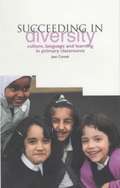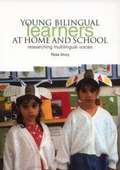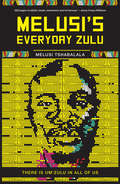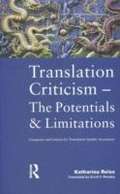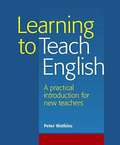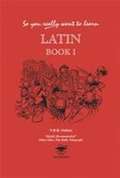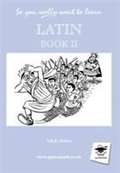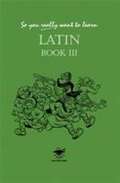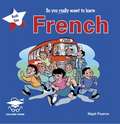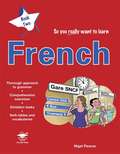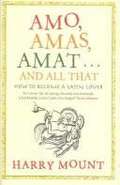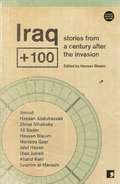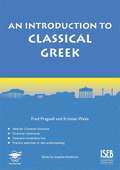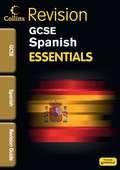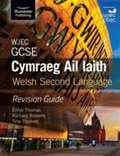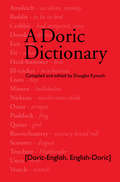- Table View
- List View
Succeeding In Diversity: Culture, Language And Learning In Primary Classrooms (PDF)
by Jean ContehJean Conteh traces a group of successful bilingual learners as they progress through Key Stage 2 in mainstream classrooms to show how successful children are helped by their interactions and experiences at home and school to move confidently between social worlds, cultures and languages in their daily lives. These are the fortunate children: the skills, knowledge and strategies they display in all these interactions are, as Dr Conteh describes, recognized and valued in classroom pedagogy and in assessing their achievements in school. But they are the exception - most bilingual learners are still condemned to failure in school. The implications for educational policy, teacher education and classroom practice of this case study are set out and linked in new ways with established knowledge and ideas about linguistics, learning and language in the mainstream classroom. Supported with practical suggestions and resources, this book should enable primary teachers to provide what bilingual children in their class need to learn successfully.
Young Bilingual Learners at Home and School: Researching Multilingual Voices (PDF)
by Rose DruryBased on the author's ethnographic study, this book examines the experiences of three four-year-old bilingual children as they begin school in three English nursery classes. It thus provides insights into young children's use of first languages as well as English, so provides a fuller and richer picture of bilingual children's learning. The book reveals some of the ways young bilingual children experience nursery as they begin to learn the language required for formal schooling. It demonstrates how they take control of their own learning at home. And it asks questions: How do Samia, Maria and Nazma find their own way through nursery? What are their individual strategies for getting by and, beyond that, for learning during their first year of formal schooling? How do they syncretise home and school learning? The detailed picture that emerges fills in the detail missing from the current over-generalised view of bilingual children in the early years and provides an important new perspective to a growing body of literature on young bilinguals. It will be essential reading for all teachers, early childhood practitioners and early years policy makers operating in multilingual environments.
Collins Easy Learning French Dictionary (Volume 4 of 6) (PDF)
by Horst KopleckVolume 4 of 6: English to French - A to F The font size in this large print edition is 18 point. This dictionary provides beginners of French with the easiest way to learn the language. Its features include full coverage of core vocabulary in both French and English, thousands of examples to show how to use the translations and all essential set expressions. The layout is clear and user-friendly.
Collins Easy Learning French Dictionary (Volume 5 of 6) (PDF)
by Horst KopleckVolume 5 of 6: English to French - G to P The font size in this large print edition is 18 point. This dictionary provides beginners of French with the easiest way to learn the language. Its features include full coverage of core vocabulary in both French and English, thousands of examples to show how to use the translations and all essential set expressions. The layout is clear and user-friendly.
Collins Easy Learning French Dictionary (Volume 3 of 6) (PDF)
by Horst KopleckVolume 3 of 6: French to English - P to Z. The font size in this large print edition is 18 point. This dictionary provides beginners of French with the easiest way to learn the language. Its features include full coverage of core vocabulary in both French and English, thousands of examples to show how to use the translations and all essential set expressions. The layout is clear and user-friendly.
Collins Easy Learning French Dictionary (Volume 6 of 6) (PDF)
by Horst KopleckVolume 6 of 6: English to French - Q to Z. The font size in this large print edition is 18 point. This dictionary provides beginners of French with the easiest way to learn the language. Its features include full coverage of core vocabulary in both French and English, thousands of examples to show how to use the translations and all essential set expressions. The layout is clear and user-friendly.
Collins Easy Learning German Dictionary (Volume 2 of 6) (PDF)
by CollinsVolume 2 of 6: German to English - G to R. The font size in this large print edition is 18 point. This dictionary provides beginners of German with the easiest way to learn the language. Its features include full coverage of core vocabulary in both German and English, thousands of examples to show how to use the translations and all essential set expressions. The layout is clear and user-friendly. The Collins Easy Learningnbsp;Frenchnbsp;and Spanish dictionaries are also available.
Collins Easy Learning German Dictionary (Volume 2 of 6) (PDF)
by CollinsVolume 2 of 6: German to English - G to R. The font size in this large print edition is 18 point. This dictionary provides beginners of German with the easiest way to learn the language. Its features include full coverage of core vocabulary in both German and English, thousands of examples to show how to use the translations and all essential set expressions. The layout is clear and user-friendly. The Collins Easy Learningnbsp;Frenchnbsp;and Spanish dictionaries are also available.
Melusi’s Everyday Zulu: There is um’Zulu in all of us
by Melusi TshabalalaDuduza. Bopha. Imbiza. Phapha. Asixoliseni. Amapopeye . . . What is the power of a single word?Six days a week, advertising creative Melusi Tshabalala posts a Zulu word on his Everyday Zulu Facebook page and tells a story about it. His off-beat sense of humour, razor-sharp social observations and frank political commentary not only teaches his followers isiZulu but also offer insight into the world Melusi inhabits as a 21st century Zulu man.Over the past few months he has built up a big and a loyal following that include radio host Jenny Crwys-Williams and Afrikaans author Marita van der Vyfer. He pokes fun at our differences and makes us laugh at ourselves and each other.Melusi asks critical questions of everyone, from Aunty Helen, Dudu-Zille to Silili (Cyril Ramaphosa) and even Woolworths (why are their aircons always set on ‘jou moer’?) His fans love him for his honesty and commitment to pointing out subtle and overt forms of prejudice and racism.Melusi’s Everyday Zulu holds up a mirror that shows South African society in all its flaws and its sheer humanity. Most importantly, he shows the power of words and that there’s um’zulu in all of us!
Dyslexia, Languages and Multilingualism (PDF)
by John EverattPopulations are becoming more mobile, leading to sometimes dramatic changes in societies. These changes can lead to classrooms in which children speak a home/first language that is different from the language of education. In places of relatively large immigration, there may be a range of home/first languages spoken by children in a local school – in one, near to the University of Canterbury, New Zealand, over a dozen first languages were spoken by young children in a recent class, despite English being the only language spoken by their teacher.
Translation Criticism: Categories and Criteria for Translation Quality Assessment (PDF)
by Katharina ReissKatharina Reiss's now classic contribution to Translation Studies, Mglichkeiten und Grenzen der bersetzungskritik: Kategorien und Kriteren fr eine sachgerechte Beurteilung von bersetzungen, first appeared in 1971. This is the first English translation of this major work, allowing students and practitioners of translation in the English-speaking world to make more extensive use of Reiss's pioneering treatment of a central theme in translation: how to develop reliable criteria for the systematic evaluation of translations. Using a wealth of interesting and varied examples, Reiss offers a systematic and illuminating text typology, a pragmatic approach to text analysis, a functional perspective on translation and a hermeneutic view of the translator, thus accounting for some of the most important aspects of the translation process: the text (both source and target versions), the conditions which determine the translator's decisions, and the translator as an individual whose personal interpretation has to be respected by any critic. In the three decades since Katharina Reiss wrote, the terminology of translation studies has evolved on many fronts. Erroll Rhodes' translation strikes an optimal balance between remaining faithful to the original presentation and using terminology that today's reader would generally understand and value.
Learning to Teach English: A Practical Introduction for New Teachers (PDF)
by Peter WatkinsLearning to Teach English Second Edition (2014) is now available. The second edition is thoroughly revised and comes with a DVD, including recordings of real lessons.
So You Really Want to Learn Latin: Book 1 (PDF)
by Oulton, N. R. R.This is the first part of a no-nonsense, grammatically based Latin course which has proved immensely popular with schools since its publication in 1999. Ideal for pupils of all abilities, Book I introduces pupils to regular verbs in all six active tenses, nouns of the first three declensions, sum, adjectives of the 1st/2nd declension, prepositions, numerals and the history of Rome from Aeneas to Cloelia.
So You Really Want to Learn Latin: Book II (PDF)
by Oulton, N. R. R.Book II takes pupils through 3rd declension adjectives, personal and demonstrative pronouns, relative clauses, 4th and 5th declension nouns, the passive voice, the comparison of adjectives and adverbs, irregular verbs and the history of Rome from Coriolanus to the 2nd Punic War. A thorough grounding for pupils attempting Level 2 of Common Entrance, this book completes the essential preliminary groundwork for the GCSE course
So You Really Want to Learn Latin: Book III (PDF)
by Nicholas OultonThe third in this three part series takes pupils through all the major syntactical constructions in a thorough, systematic way, with clear explanations and suitable pasSAGE Publishings for translation. The book concludes with an introduction to the complexities of Latin scansion. Vital as a hand-book for pupils taking GCSE or preparing for Common Entrance or scholarship exams at 13+
So You Really Want to Learn French Book 1 (PDF)
by Nigel PearceA clear and simple introduction to learning a language.This first French book takes a no-nonsense approach to the elementary stages of French with clear, grammatical explanations and challenging exercises.nbsp;
French (PDF)
by Nigel PearceThe second book in this three-part series is suitable for pupils with a good basic knowledge of French. It completes the grammar and topics required for Key Stage 3 and Common Entrance at 13+ in a lively yet structured way, as well as providing a thorough knowledge of the basic language skills required for GCSE. Through the use of a storyline and dialogues, increasingly advanced work is introduced and practised, with full and clear explanation. The Audio CD is not included with this textbook and must be purchased separately. For more information about this product please visit www. galorepark. co. uk. - The second part in this grammar-based course for pupils who want to learn how to use and manipulate the French language with confidence, with translation exercises throughout to consolidate pupils' knowledge - Verb tables, irregular verb tables, French to English and English to French vocabularies are featured at the back of the book for quick and easy reference - An Audio CD, Assessment Pack CD and Answer Book which contains answers to all the exercises are also available to purchase separately to accompany the book
Amo, Amas, Amat - And All That: Put A Little Latin In Your Life (PDF)
by Harry MountUncover the hidden charms of Latin
Iraq + 100: Stories From A Century After The Invasion
by Hassan Abdulrazzak Ibrahim Al-Marashi Zhraa Alhaboby Ali Bader Hassan Blasim Mortada Gzar Jalal Hasan Diaa Jubaili Anoud Khalid KakiIraq + 100 poses a question to ten Iraqi writers: what might your country look like in the year 2103 – a century after the disastrous American- and British-led invasion, and 87 years down the line from its current, nightmarish battle for survival? How might the effects of that one intervention reach across a century of repercussions, and shape the lives of ordinary Iraqi citizens, or influence its economy, culture, or politics? Might Iraq have finally escaped the cycle of invasion and violence triggered by 2003 and, if so, what would a new, free Iraq look like? Covering a range of approaches – from science fiction, to allegory, to magic realism – these stories use the blank canvas of the future to explore the nation’s hopes and fears in equal measure. Along the way a new aesthetic for the ‘Iraqi fantastical’ begins to emerge: thus we meet time-travelling angels, technophobic dictators, talking statues, macabre museum-worlds, even hovering tiger-droids, and all the time buoyed by a dark, inventive humour that, in itself, offers hope.
An Introduction to Classical Greek (Level 1/2) (PDF)
by Kristian Waite Fred PragnellThis textbook is ideal for any pupil working towards Level 1 or Level 2 of the Common Entrance Classical Greek exam at 13+. It introduces pupils to Greek grammar and vocabulary and features clear explanations and challenging practice questions to help pupils develop their exam technique. Several unseen passages are also included, to help pupils perfect their translation skills. Suitable for ISEB 13+ Greek exams up to and including Summer 2014. - Endorsed by ISEB - Ideal for pupils working towards Levels 1 or Level 2 of the Classical Greek Common Entrance exam at 13+ - Introduces pupils to essential Greek grammar and vocabulary - Features clear explanations followed by extensive practice questions so pupils can check what they have learnt - Unseen passages to help pupils perfect their translation skills are also included An Answer Book is also available to accompany this book. 9781905735860
Spanish: Revision Guide (PDF)
by Terry MurrayThe student-friendly, uncluttered approach to GCSE revision, guides students through the core Spanish content with succinct revision notes and practice questions that focus on the essential content needed for the exams.
Let the Right One In (Devil's Advocates)
by Anne BillsonThese days it takes a very special vampire movie to stand out. Like Twilight, the Swedish film Let the Right One In is a love story between a human and a vampire but there the resemblance ends. Let the Right One In is not a romantic fantasy but combines the supernatural with social realism. Set on a housing estate in the suburbs of Stockholm in the early 1980s, it's the story of Oskar, a lonely, bullied child, who makes friends with Eli, the girl in the next apartment. 'Oskar, I'm not a girl,' she tells him and she's not kidding. They forge a relationship which is oddly innocent yet disturbing, two outsiders against the rest of the world. But one of these outsiders is, effectively, a serial killer. While Let the Right One In is startlingly original, it nevertheless couldn't have existed without the near century of vampire cinema that preceded it. Acclaimed film critic and horror novelist Anne Billson looks at how it has drawn from, and wrung new twists on, such classics as Nosferatu (1922), how vampire cinema has already flirted with social realism in films like Near Dark (1987) and how vampire mythology adapts itself to the modern world.
Cicero, Against Verres, 2.1.53–86: Latin Text with Introduction, Study Questions, Commentary and English Translation (Classics Textbooks #1)
by Ingo GildenhardLooting, despoiling temples, attempted rape and judicial murder: these are just some of the themes of this classic piece of writing by one of the world’s greatest orators. This particular passage is from the second book of Cicero’s Speeches against Verres, who was a former Roman magistrate on trial for serious misconduct. Cicero presents the lurid details of Verres’ alleged crimes in exquisite and sophisticated prose. This volume provides a portion of the original text of Cicero’s speech in Latin, a detailed commentary, study aids, and a translation. As a literary artefact, the speech gives us insight into how the supreme master of Latin eloquence developed what we would now call rhetorical "spin”. As an historical document, it provides a window into the dark underbelly of Rome’s imperial expansion and exploitation of the Near East. Ingo Gildenhard’s illuminating commentary on this A-Level set text will be of particular interest to students of Latin at both high school and undergraduate level. It will also be a valuable resource to Latin teachers and to anyone interested in Cicero, language and rhetoric, and the legal culture of Ancient Rome.
GCSE Welsh Second Language (Cymraeg Ail laith) (PDF)
by Enfys Thomas Richard Roberts Tina ThomasEndorsed by WJEC, this is a detailed and comprehensive guide full of ideas and suggestions to help students develop their key Welsh language skills. With a wide range of solo, pair and group tasks and activities throughout it is ideal for reinforcing exam skills across all four units of the WJEC GCSE Welsh Second Language specification. Written by experienced authors, examiners and practising teachers, it offers high quality support you can trust. Provides a practical unit-by-unit approach, ensuring that students have focused coverage of the required language skills. Offers spontaneous speaking and translation practice throughout to allow students to perfect these crucial skills. Units 1 & 2 are supported by links to digital files to enable further practice of speaking and listening skills and help to ensure students are fully prepared for their non-examination assessment. Plenty of practice questions and tasks with exemplar responses to see where extra marks can be gained. Datganiad hawlfraint Gwneir y copi hwn dan dermau Rheoliadau (Anabledd) Hawlfraint a Hawliau mewn Perfformiadau 2014 i'w ddefnyddio gan berson sy'n anabl o ran print yn unig. Oni chaniateir gan gyfraith, ni ellir ei gopïo ymhellach, na'i roi i unrhyw berson arall, heb ganiatâd.
A Doric Dictionary
by Douglas KynochWhat’s the difference between a meggie-monyfeet and a hornie-gollach? Between snap-an-rattle and murly-tuck? All is explained in the Doric Dictionary. It is a two-way lexicon of words and phrases drawn from the former Banffshire in the North through Aberdeenshire to the Mearns and North Angus and drawn from the published works of most the North-east’s best-known writers of the 19th and 20th centuries. As the writer says in his foreword, ‘There is not one monolithic form of Doric but a multliplicity of forms; and words can change not only from county to county but from village to village’. The Dictionary contains no fewer than eight variants of the term for a seagull. This new version (2018) is enhanced by a most stimulating injection of Buchan vocabulary drawn from W. P. Milne’s historical novel, Eppie Elrick.
